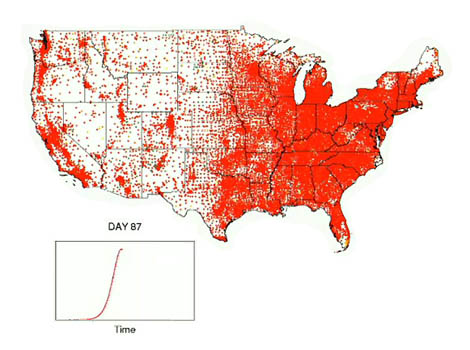Using supercomputers to respond to a potential American health emergency, scientists from Los Alamos National Laboratory in New Mexico, the University of Washington and the Fred Hutchinson Cancer Research Center in Seattle have developed a simulation model that makes stark predictions about the possible future course of an avian influenza pandemic.

Based on today’s environment of world-wide connectivity, beginning with 10 infected people arriving in Los Angeles, the simulation predicts that the pandemic will spread quickly throughout the continental United States, peaking about 90 days after the initial introduction.
The computer simulation models a synthetic population that matches U.S. census demographics and worker mobility data by randomly assigning the simulated individuals to households, workplaces, schools, and the like. Department of Transportation travel data is used to model long-distance trips during the course of the simulation, realistically capturing the spread of the pandemic virus by airplane and other passenger travel across the United States.
“In the highly mobile U.S. population, travel restrictions alone will not be enough to stop the spread; a mixture of many mitigation strategies is more likely to be effective than a few strictly enforced ones,” said Kadau, also of Los Alamos’ Theoretical Division.
The number of symptomatic cases at any point in time is shown on a logarithmic color scale, with 1 or fewer cases per 1000 in green, 50 per 1000 in yellow, and 100 or more per 1000 in red.
Simulation of a pandemic flu outbreak. (4mb Quicktime)